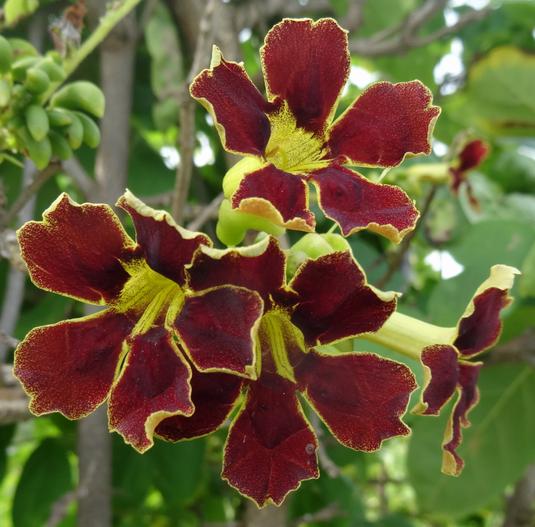Bell Bean Tree
(Markhamia zanzibarica)
Bell Bean Tree (Markhamia zanzibarica)
/
/

Ton Rulkens
CC BY-SA 2.0
Image By:
Ton Rulkens
Recorded By:
Copyright:
CC BY-SA 2.0
Copyright Notice:
Photo by: Ton Rulkens | License Type: CC BY-SA 2.0 | License URL: https://creativecommons.org/licenses/by-sa/2.0 | Uploader: Josve05a | Publisher: Wikipedia Commons













Estimated Native Range
Summary
Markhamia zanzibarica, commonly known as the Bell Bean Tree or Maroon Bell-Bean, is a deciduous tree native to a variety of habitats in East and Southern Africa, including Kenya, Tanzania, Mozambique, and South Africa. It thrives in open woodlands, riverine fringes, and rocky outcrops. This species typically reaches heights of 20-30 feet (6-9 meters) with a canopy spread of 15-20 feet (4.5-6 meters). The Bell Bean Tree is characterized by its pinnate leaves and clusters of showy, trumpet-shaped yellow flowers with maroon streaks, which bloom from late summer to fall. The flowers are followed by long, slender seed capsules that persist on the tree.
The Bell Bean Tree is valued for its ornamental appeal, particularly its vibrant flowers that attract pollinators such as bees and butterflies. It is used in tropical and subtropical landscapes for shade, as a specimen tree, or planted along streets. In cultivation, it requires well-drained soils and can tolerate drought once established, making it suitable for xeriscaping. It prefers full sun to partial shade. While generally pest-free, it can be susceptible to root rot in poorly drained soils. The Bell Bean Tree is also used for reforestation projects and erosion control due to its fast growth rate and adaptability.CC BY-SA 4.0
The Bell Bean Tree is valued for its ornamental appeal, particularly its vibrant flowers that attract pollinators such as bees and butterflies. It is used in tropical and subtropical landscapes for shade, as a specimen tree, or planted along streets. In cultivation, it requires well-drained soils and can tolerate drought once established, making it suitable for xeriscaping. It prefers full sun to partial shade. While generally pest-free, it can be susceptible to root rot in poorly drained soils. The Bell Bean Tree is also used for reforestation projects and erosion control due to its fast growth rate and adaptability.CC BY-SA 4.0
Plant Description
- Plant Type: Tree
- Height: 15-20 feet
- Width: 10-15 feet
- Growth Rate: Moderate
- Flower Color: Yellow
- Flowering Season: Summer
- Leaf Retention: Deciduous
Growth Requirements
- Sun: Full Sun
- Water: Medium
- Drainage: Medium, Fast
Common Uses
Border Plant, Butterfly Garden, Low Maintenance, Potted Plant, Showy Flowers
Natural Habitat
native to a variety of habitats in East and Southern Africa, including Kenya, Tanzania, Mozambique, and South Africa
Other Names
Common Names: Bell Bean Tree, Nile Tulip Tree
Scientific Names: , Markhamia zanzibarica, Dolichandrone hirsuta, Dolichandrone latifolia, Dolichandrone stenocarpa, Markhamia acuminata, Markhamia puberula, Markhamia stenocarpa, Muenteria puberula, Muenteria stenocarpa
GBIF Accepted Name: